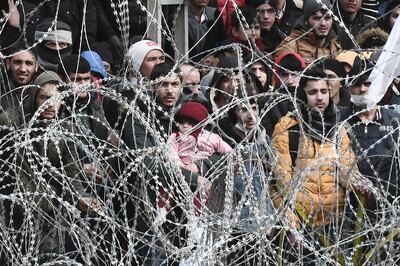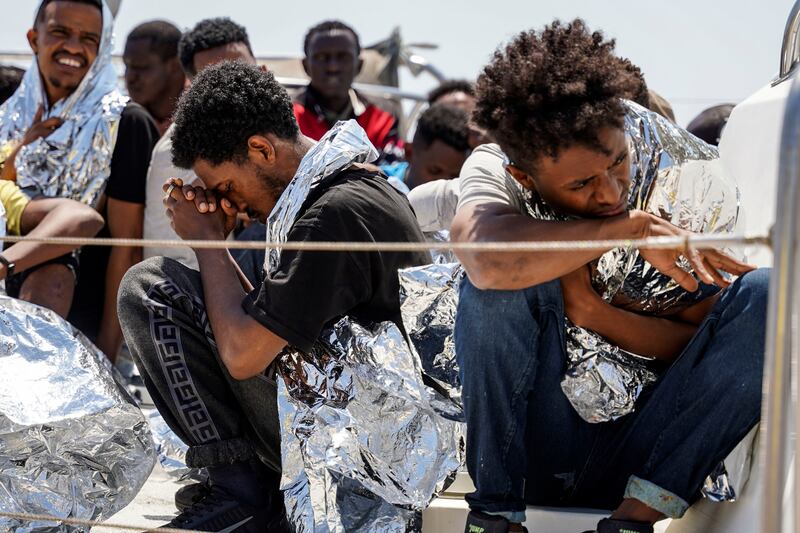One hundred years ago this month, a young reporter for the Toronto Star turned up in eastern Thrace to witness the exodus of Greeks, who had two weeks to move west of the Evros River, along with the Greek army, after the signing of an armistice ending the First World War in the Ottoman region.
“Twenty miles of carts drawn by cows, bullocks and muddy-flanked water buffalo, with exhausted, staggering men, women and children, blankets over their heads, walking blindly along in the rain beside their worldly goods,” Ernest Hemingway wrote in October 1922 from Adrianople, or present-day Edirne, near the Turkey-Greece border.
This rugged, mountainous peninsula has over the ages seen a vast array of troubled folk, so it should come as little surprise that a century later it is again the site of migrant misery. Just last week, Greek authorities discovered nearly 100 men huddling in a marsh along the border. Mainly from Afghanistan and Syria, they were not only hungry, exhausted and completely naked but many had also sustained injuries.
Greek Migration Minister Notis Mitarachi shared a photo of the group on Twitter, blaming the incident on Turkey and calling it “a shame for civilisation“. His colleague Takis Theodorikakos, the Greek Minister for Civil Protection, said the Turkish government was to blame. Turkey has denied any involvement, while the UN Refugee Agency called for a full investigation.
Either side, or smugglers, could be to blame. Earlier this year, the Turkish government detained and deported hundreds of Syrians back to their homeland, in some cases beating and abusing them, according to a new report by US-based advocacy group Human Rights Watch.

In an April report, meanwhile, Human Rights Watch detailed how Greece had been pushing migrants back into Turkey after taking away their phones, valuables and clothing before sending them on their way.
This latest incident highlights an element that has been largely overlooked amid the accusations between Ankara and Athens: the desperate suffering of millions of Syrians, Iraqis, Tunisians, Afghans, Iranians and others who fled instability and violence and have been seeking some semblance of stability and security for up to a decade.
Their plight has grown more difficult in the past year. Turkey is home to more than 4 million refugees and appears to be taking a nativist turn as locals increasingly blame outsiders for their economic troubles. Syrians face regular verbal and physical abuse in public and a recent short film denouncing their presence as a “silent invasion” went viral. Their living options are shrinking almost by the day: the government has barred foreigners from settling in more than 1,100 districts in nearly 60 cities.
Greece has hardly been a sanctuary in comparison. European Commission President Ursula von der Leyen has described Greece as “Europe’s shield” on immigration, encouraging continued harsh policies along the border. Yet earlier this year, Mr Mitarachi said Ukrainians are “real refugees” and vowed to take in thousands of them.
Middle Eastern, African and South Asian migrants are increasingly unwelcome, and those who seek safe harbour elsewhere are less likely to end up living the good life in Europe than shivering and scared in a forest. Or worse: just last week, the bodies of two young Palestinian men washed up on a Greek beach. The men had tried to swim from Turkey.
Their troubles bring to mind another long-suffering community in the Turkey-Greece border region. North-eastern Greece is home to as many as 100,000 people of Turkish heritage whose culture and identity have been all but erased. Turks first arrived in western Thrace when the Ottoman Empire conquered the region nearly seven centuries ago.
By the early 20th century, they represented the majority in areas such as Xanthi and Komotini, and in 1913 formed a provisional government that some consider the first Turkish Republic. But with the end of the First World War and Turkey’s defeat of Greece in its war for independence, followed by the population exchange detailed by Hemingway, the ground began to shift beneath their feet.

In 1955, in response to the pogroms against Greeks and other non-Muslim communities in Turkey, the Greek government decided that people of non-Greek origin who left the country with no intention to return would lose their Greek nationality. By 1998, when the law was repealed, some 60,000 Greek Muslims, mainly Turks, had lost their citizenship.
Since the 1980s, Athens has referred to them as Greek Muslims. This is due to fears of the area becoming a “second Cyprus” or being ceded to Turkey. Any domestic organisation that includes the word “Turk” or “Turkish” in its name is shut down, with Greek courts arguing that those words refer to citizens of Turkey, not Greece, and could thus endanger public order.
As many as 400,000 Turks have left western Thrace in the past century, while those who remain face severe curbs. Some years ago, Human Rights Watch highlighted "a hodge-podge, neglected, and woefully inadequate educational system for the Turkish minority".
Much of this echoes Turkey’s treatment of its Kurds, a much larger population, and the experience of Pontic Greeks, who were forced to leave en masse upon the creation of the Republic of Turkey and now number just 5,000 in Turkey’s Black Sea region.
But the Kurds are widely lionised and championed in the West, and the Greek exodus and mass killings during the Greco-Turkish war have gained considerable international sympathy in recent decades, so the suffering of these peoples has at least gained wider notice.
The story of Turkish Greeks, on the other hand, has been largely ignored, which may have cost us. German researchers recently discovered thousands of 14th-century Ottoman manuscripts at Pantokrator, an Orthodox Christian monastery on Mount Athos, some 50 kilometres into the Aegean from the western Thrace resort of Kavala.
They reveal that the conquering Turks protected the region and preserved its autonomy, allowing the monks to continue their rites and practices as they had for centuries. Father Theophilos, a Pantokrator monk helping with the research, said the Ottoman documents illustrate “how people can live with each other” and lay out “the principles of social co-existence”.
Sounds like principles we could use today.





